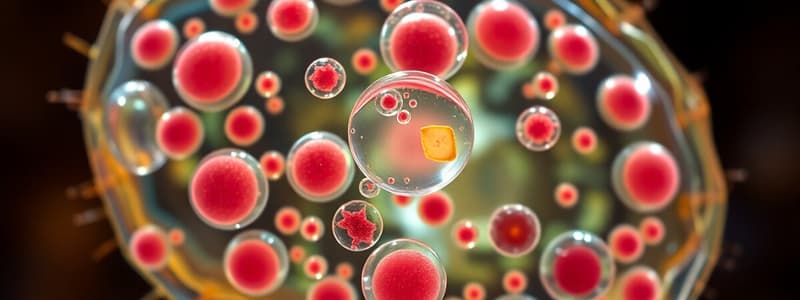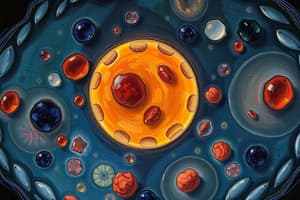Podcast
Questions and Answers
Which of the following best describes the primary difference between eukaryotic and prokaryotic cells?
Which of the following best describes the primary difference between eukaryotic and prokaryotic cells?
- Eukaryotic cells are more complex and include animal and plant cells. (correct)
- Prokaryotic cells are complex and contain organelles.
- Eukaryotic cells are smaller and simpler.
- Prokaryotic cells always require a microscope for viewing.
Organelles are large structures easily visible without a microscope.
Organelles are large structures easily visible without a microscope.
False (B)
What is the main function of the nucleus in a cell?
What is the main function of the nucleus in a cell?
to contain the genetic material and control the cell's activities
The cell membrane forms the ______ surface of the cell and controls what goes in and out.
The cell membrane forms the ______ surface of the cell and controls what goes in and out.
Match the following organelles with their primary functions:
Match the following organelles with their primary functions:
Which organelle is responsible for most of the reactions for aerobic respiration in a cell?
Which organelle is responsible for most of the reactions for aerobic respiration in a cell?
The cytoplasm is a solid structure where proteins are made.
The cytoplasm is a solid structure where proteins are made.
What process occurs in chloroplasts, and what substance is essential for this process?
What process occurs in chloroplasts, and what substance is essential for this process?
The rigid structure surrounding the cell membrane in plant cells is called the ______.
The rigid structure surrounding the cell membrane in plant cells is called the ______.
Which of the following is a function of the vacuole in plant cells?
Which of the following is a function of the vacuole in plant cells?
Animal cells contain a cell wall made of cellulose.
Animal cells contain a cell wall made of cellulose.
What is the function of ribosomes?
What is the function of ribosomes?
The cell wall is made of ______.
The cell wall is made of ______.
Which of these organelles is found in plant cells but not typically in animal cells?
Which of these organelles is found in plant cells but not typically in animal cells?
Enzymes are found in the nucleus and control genetic reactions.
Enzymes are found in the nucleus and control genetic reactions.
Name three organelles found in a typical animal cell?
Name three organelles found in a typical animal cell?
The green substance called ______, found in chloroplasts, is used in photosynthesis.
The green substance called ______, found in chloroplasts, is used in photosynthesis.
If a substance is moving 'in and out' of a cell, which structure is primarily controlling this movement?
If a substance is moving 'in and out' of a cell, which structure is primarily controlling this movement?
All cells, whether prokaryotic or eukaryotic, contain organelles.
All cells, whether prokaryotic or eukaryotic, contain organelles.
Which of the following describes cell sap?
Which of the following describes cell sap?
Flashcards
Cell types
Cell types
Cells can be eukaryotic or prokaryotic.
Organelles
Organelles
Tiny structures within cells that perform specific functions.
Nucleus
Nucleus
Organelle containing genetic material, controlling the cell's activities, and surrounded by a membrane.
Cell membrane
Cell membrane
Signup and view all the flashcards
Cytoplasm
Cytoplasm
Signup and view all the flashcards
Mitochondria
Mitochondria
Signup and view all the flashcards
Ribosomes
Ribosomes
Signup and view all the flashcards
Chloroplasts
Chloroplasts
Signup and view all the flashcards
Vacuole
Vacuole
Signup and view all the flashcards
Cell wall
Cell wall
Signup and view all the flashcards
Study Notes
- Organisms consist of cells, which are like tiny building blocks.
Cells and Organelles
- Cells can be either eukaryotic or prokaryotic.
- Eukaryotic cells are complex and found in animal and plant cells.
- Prokaryotic cells are smaller and simpler; bacteria are an example.
- Organelles are tiny structures located within cells.
- Organelles can only be seen using a microscope.
Typical Animal Cell Organelles
- Nucleus: organelle containing the genetic material that controls the cell's activities, surrounded by own membrane.
- Cell membrane: a membrane forming the outer surface, that controls the substances that go in and out of the cell.
- Cytoplasm: a gel-like substance where most of the cell's chemical reactions happen, contains enzymes.
- Mitochondria: small organelles where most of the reactions for aerobic respiration take place. Respiration transfers energy the cell needs to work.
- Ribosomes: small organelles where the cell makes proteins.
Typical Plant Cell Structures
- Plant cells have all the organelles of animal cells, plus a few extra.
- Chloroplasts: where photosynthesis happens, making food for the plant.
- Chloroplasts contain the green substance chlorophyll, which is used in photosynthesis.
- Vacuole: a large organelle which contains cell sap (a weak solution of sugars and salts), helps support the cell.
- Cell wall: a rigid structure made of cellulose, surrounds the cell membrane, supports and strengthens the cell.
Studying That Suits You
Use AI to generate personalized quizzes and flashcards to suit your learning preferences.



